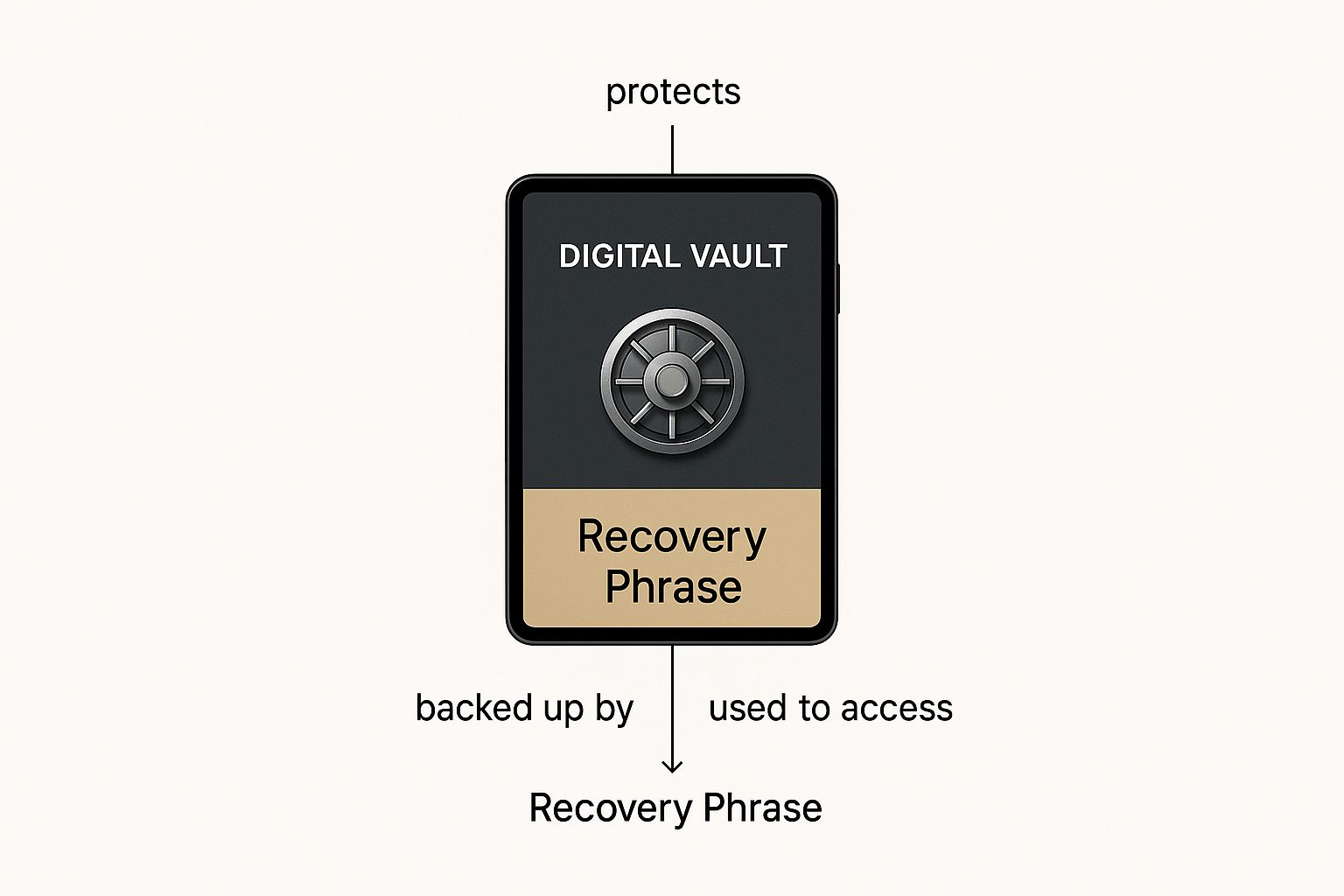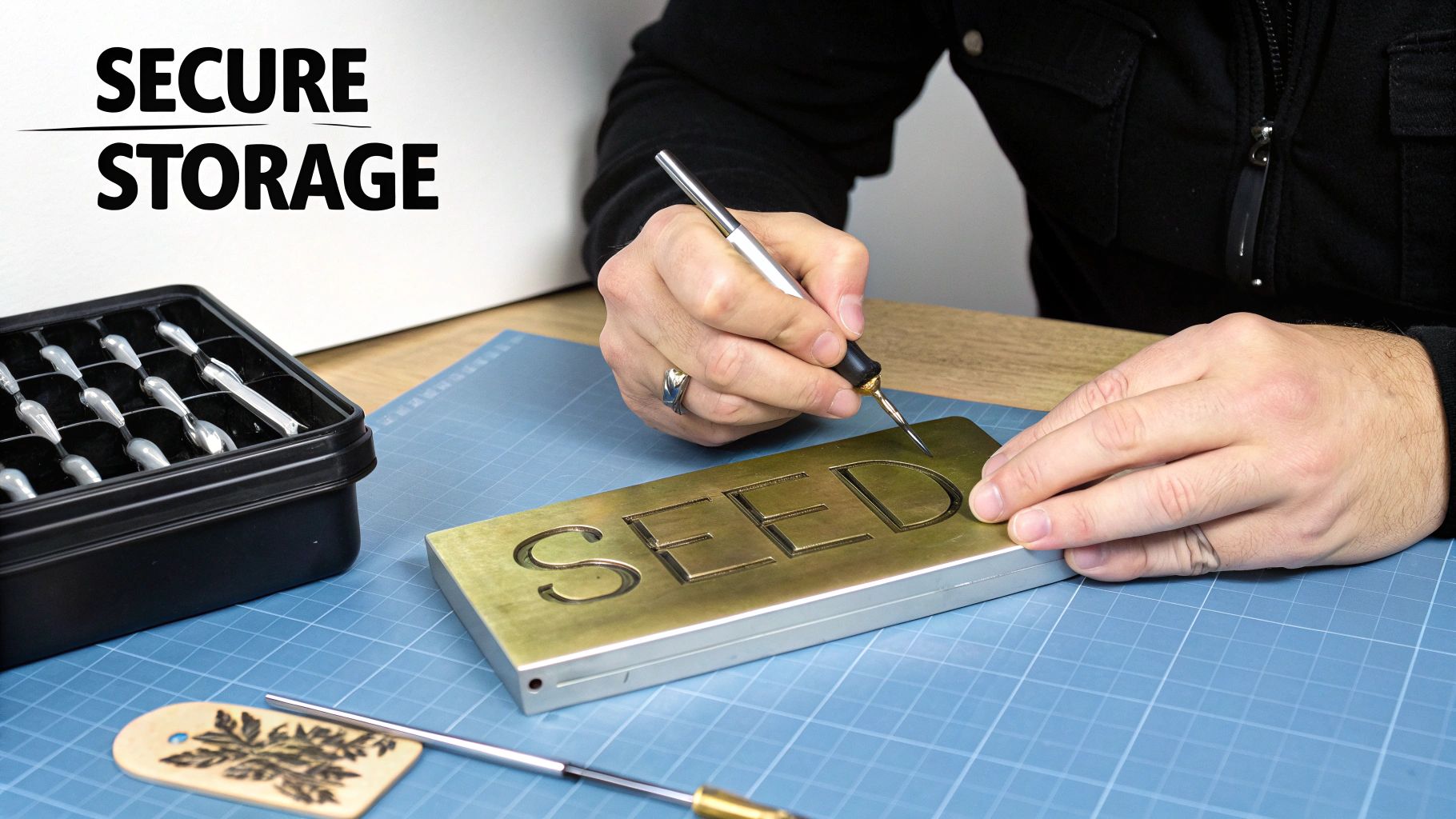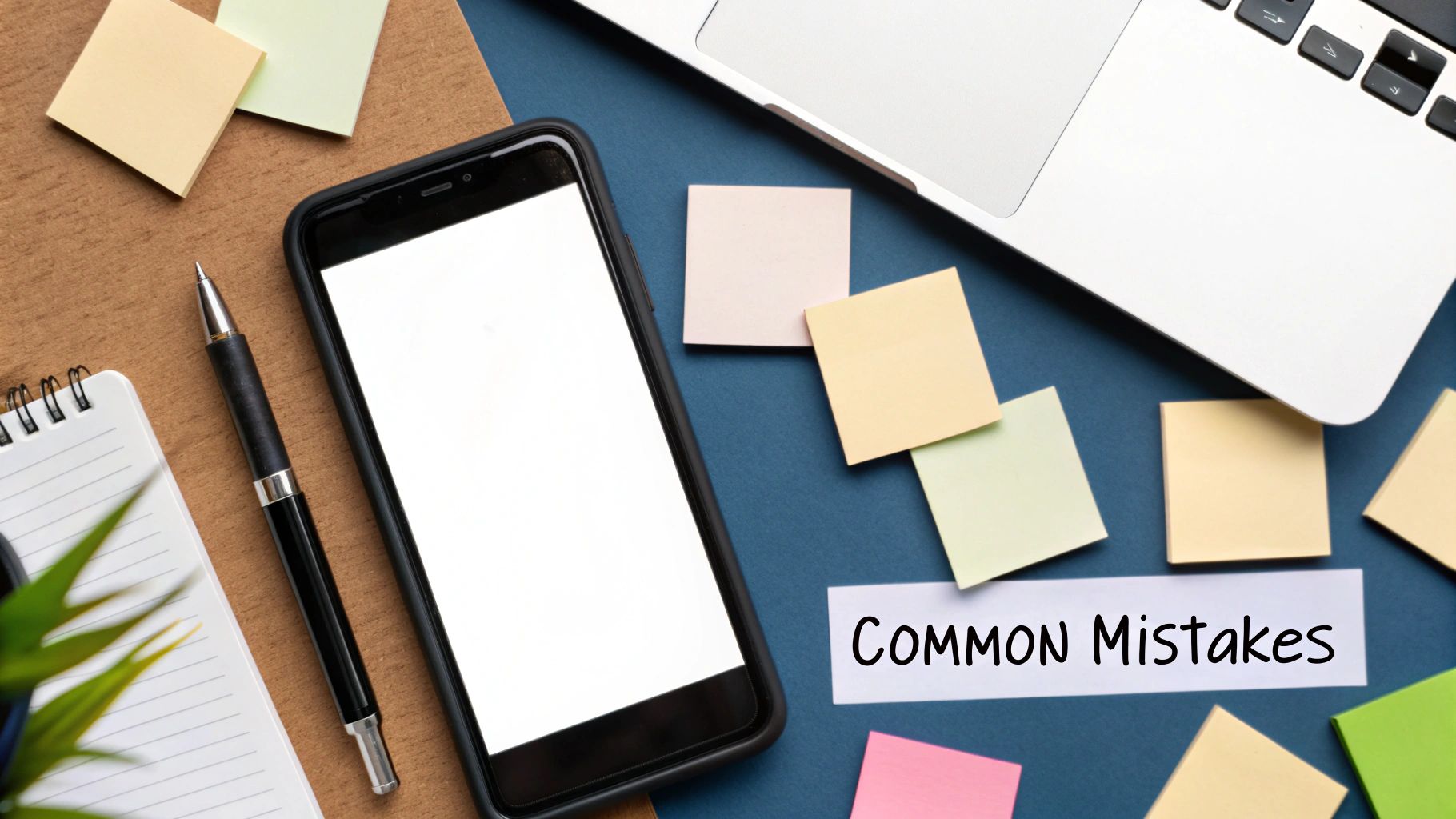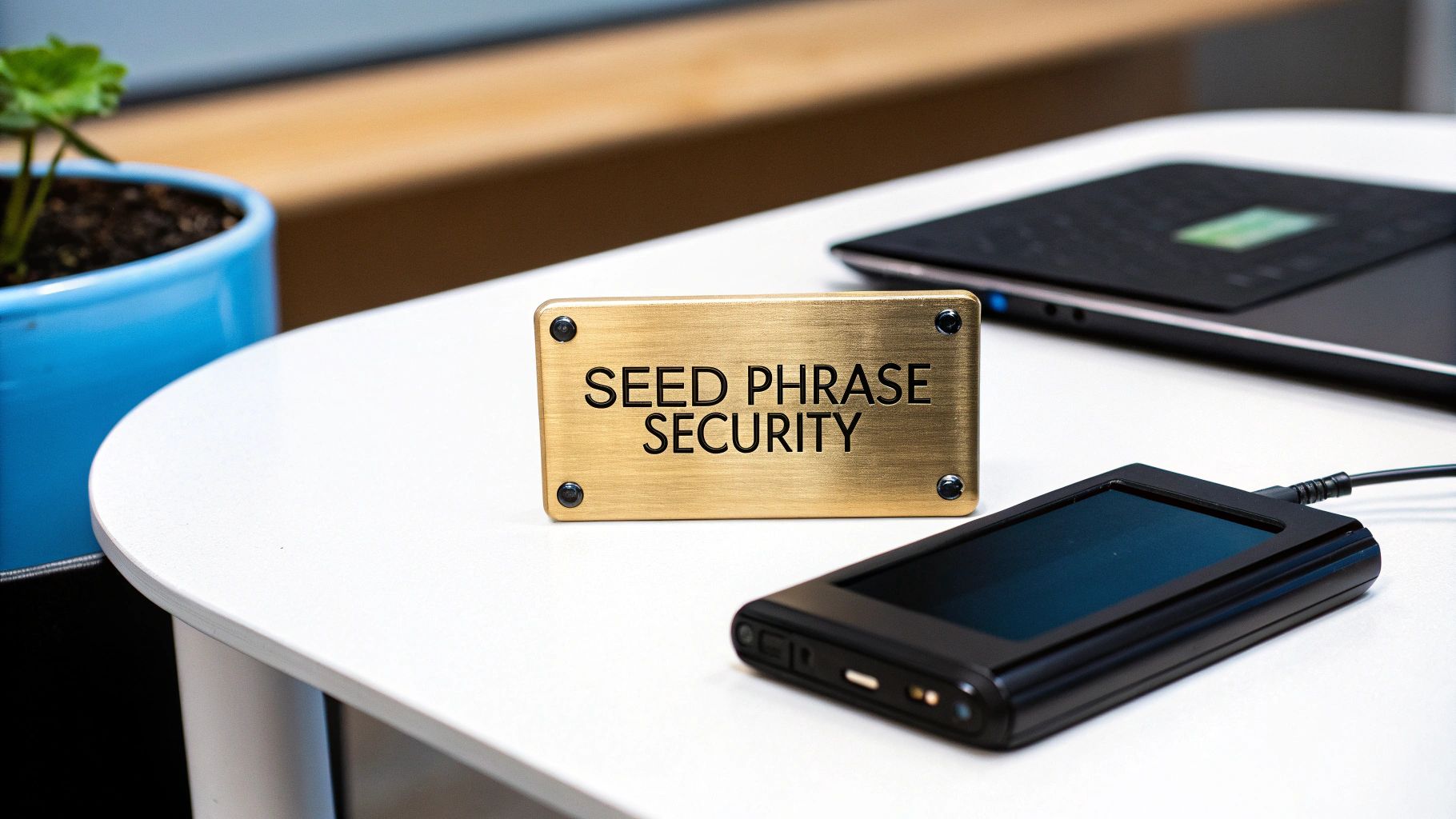A wallet recovery phrase, often called a seed phrase, is a list of 12 to 24 random words that acts as the master key to your entire crypto portfolio. It is the only thing that can get your assets back if your phone breaks, your laptop gets stolen, or you simply forget your password.
This makes it the single most important piece of information you own in the crypto world.
The Ultimate Key to Your Digital Vault
Think of your crypto wallet less like a bank account and more like a personal, impenetrable vault. Your daily password or PIN is like a keycard—it gets you in and out for everyday transactions.
But what if you lose the keycard? Or worse, what if the entire building (your phone or computer) disappears? At a normal bank, you'd just go to another branch and show your ID.
In the self-custody world of crypto, there's no bank manager to call and no "forgot password" button to click. Your wallet recovery phrase is the master blueprint to that vault. It doesn't just unlock it; it lets you rebuild the entire thing, with every last satoshi inside, on any compatible device, anywhere in the world.
This is what true ownership feels like. It’s empowering, but it also comes with a huge amount of responsibility. If you lose that phrase, it's like burning the blueprints—the vault is sealed forever.
The Anatomy of a Recovery Phrase
This master key isn't just a jumble of words. It's generated using a specific cryptographic standard called Bitcoin Improvement Proposal 39 (BIP39). This protocol uses a carefully selected list of 2048 English words to create your unique phrase.
Here’s what makes it tick:
- Length: You'll usually see 12, 18, or 24 words. The longer the phrase, the stronger the security. A 12-word phrase alone has trillions of combinations, making it practically impossible for anyone to guess.
- Order: The sequence is everything. The words must be in the exact order they were given. "Apple banana cherry" is a totally different key from "Cherry banana apple."
- Function: This phrase is the "seed" from which every single private key in your wallet is mathematically derived. That’s how one phrase can secure Bitcoin, Ethereum, and countless other assets all at once.
The infographic below shows how this one phrase sits at the very heart of your wallet's security.

As you can see, the recovery phrase is the ultimate source of truth, giving you the power to regenerate complete access to all your digital assets from scratch.
Why It Demands Your Full Attention
I can't overstate this: mishandling your recovery phrase has severe and irreversible consequences. Experts estimate that somewhere between 2.3 million and 3.7 million Bitcoin are gone for good, mostly because people lost or forgot their seed phrases.
That staggering number should be a wake-up call. Treat your recovery phrase with the respect it deserves, because once it's gone, there is no one—no company, no developer, no authority—who can help you get your funds back. If you want to dive deeper, you can discover more about the impact of lost crypto keys and how it shakes the market.
A wallet password protects you from someone grabbing your unlocked phone. A wallet recovery phrase protects you from the phone itself being lost, stolen, or smashed to pieces. Getting this distinction right is the foundation of crypto security.
To wrap this up, let's break down the core features of a recovery phrase in a simple table.
Wallet Recovery Phrase At a Glance
This table gives a quick rundown of what makes a recovery phrase so powerful and unique.
| Characteristic | Description | Why It's Important |
|---|---|---|
| Universality | Based on the BIP39 standard, it works with most other compatible software or hardware wallets. | You aren't tied to one wallet provider. Your funds stay yours, even if an app you use shuts down. |
| Offline Origin | It is generated and shown to you entirely on your device, without ever being broadcast over the internet. | This "air-gapped" creation process is a critical security feature that stops hackers from intercepting it at setup. |
| Total Control | Whoever holds this phrase has complete and absolute control over all the funds connected to it. | It gives you true ownership ("self-custody"), but that also means you are 100% responsible for keeping it safe. |
Understanding these three points is key to grasping why this string of words is so fundamental to owning and securing cryptocurrency.
How Your Recovery Phrase Actually Works
Your wallet recovery phrase might seem like a jumble of random words, but it’s actually an incredibly powerful cryptographic key. This isn't just another password; think of it as the master blueprint that can rebuild your entire crypto wallet from scratch. The secret sauce behind this is a universal standard called Bitcoin Improvement Proposal 39, or BIP39.
BIP39 is essentially a shared dictionary for crypto wallets, containing a very specific list of 2048 English words. When you set up a new wallet, the software plucks 12 to 24 of these words in a unique order, and voilà—that's your recovery phrase.
This whole process is designed to happen completely offline, right on your device. The phrase is created without ever connecting to the internet, which is a crucial security measure to stop sneaky hackers from peeking in during setup.
From Words to Private Keys
So, how do these simple words hold the keys to your crypto kingdom? It’s a fascinating bit of cryptography that turns your phrase into the private keys that sign off on your transactions.
It all begins with your list of words, in their exact order. The wallet software feeds this phrase into a complex algorithm to produce a single, long string of data known as a "seed." This seed is the single source of truth for your wallet; it’s the raw, cryptographic DNA from which everything else is born.
Your recovery phrase is like a secret recipe. When you punch it into any compatible wallet, the software follows that exact recipe to cook up the same master seed. That seed then generates the exact same private keys, instantly restoring access to all your funds.
This "deterministic" process is what makes it all work. As long as you have the right words in the right order, you can resurrect your wallet on any device that speaks the BIP39 language.
The Hierarchical Deterministic Wallet
Once that master seed is created, your wallet uses it to generate a nearly infinite tree of private keys and public addresses. This brilliant system is called a Hierarchical Deterministic (HD) wallet. The name sounds like a mouthful, but the idea is actually quite simple.
Picture your wallet recovery phrase as the trunk of a giant tree.
- The Trunk: Your 12 to 24-word recovery phrase.
- The Main Branches: These are the master private keys for different cryptocurrencies (one for Bitcoin, another for Ethereum, and so on).
- The Leaves: These are the individual public addresses you share to receive funds.
From that single trunk, the master seed sprouts, growing major branches for each crypto asset. Each of those branches can then grow smaller ones, which in turn can produce a countless number of leaves, or addresses.
This structure is what makes modern wallets so powerful. You can manage a diverse portfolio of assets and make thousands of transactions, all secured by that one original phrase. No more juggling hundreds of individual private keys—you just need to protect the one phrase that rules them all.
It also gives you a huge privacy boost. By generating a fresh public address for every transaction you receive, it becomes much tougher for snoops on the blockchain to connect the dots and trace all your activity back to you. But behind the curtain, your wallet knows every single one of those addresses belongs to you, because they all grew from the same master seed. It’s an elegant design that delivers security, control, and privacy from a single point of origin.
How to Secure Your Recovery Phrase

So, you understand what a recovery phrase is and the incredible power it holds. What’s next? Securing it. This isn’t just a friendly suggestion—it’s the single most critical step you’ll take to protect your crypto for the long haul.
Your mission is simple: create a backup that is completely offline and can survive anything from a hard drive failure to a house fire. That brings us to the first and most important rule of crypto security.
Never, ever store your recovery phrase digitally. That means no screenshots, no notes app, no emailing it to yourself, and definitely no password managers. If it’s on a device that connects to the internet, it’s vulnerable. Period.
Storing your phrase digitally creates a glaring target for hackers. Malware, phishing scams, and simple data breaches can expose your master key in a heartbeat, giving thieves permanent access to your funds. The only truly safe path forward is a physical, offline backup.
The Siren Song of Digital Storage
Before we get into the right way to do things, let’s be crystal clear about why digital methods are a terrible idea. Each one opens a door you really want to keep shut.
-
Screenshots and Photos: Snapping a picture of your phrase is asking for trouble. Most phones automatically back photos up to the cloud, instantly creating a copy of your master key on a server you don't control.
-
Cloud Drives and Emails: Saving your phrase in a Google Doc or an email draft is like taping your house keys to your front door. One simple breach of your cloud or email account, and it’s game over for your entire portfolio.
-
Password Managers: These tools are fantastic for website logins, but they are absolutely not built for the unique security demands of a recovery phrase. If an attacker cracks your master password, they get everything—including the keys to your crypto kingdom.
The core issue is that anything digital can be copied and stolen from anywhere in the world, often without you even knowing it happened. Physical backups take a bit more effort, but they completely shut down this entire category of risk.
Choosing Your Physical Backup Method
Securing your phrase offline isn't a one-size-fits-all deal. Your best option hinges on your personal risk tolerance, how much you're willing to spend, and your overall security setup.
It's shocking, but studies reveal that roughly 20–30% of retail cold wallet users admit to having no reliable backup of their seed phrases. That's a massive gamble. On the flip side, users with solid backup plans have far greater success in recovering their assets when something goes wrong. You can learn more about these cold wallet security statistics and see for yourself why a good backup is non-negotiable.
Let's break down the most common physical storage solutions.
Comparing Physical Backup Methods for Your Recovery Phrase
This table gives you a side-by-side look at the most popular offline methods for storing a recovery phrase, evaluating them on the criteria that matter most.
| Storage Method | Security Level | Durability (Fire/Water) | Cost | Best For |
|---|---|---|---|---|
| Paper Backup | Low-Medium | Very Low | Minimal | Quick, temporary storage before you upgrade to something more robust. |
| Laminated Paper | Medium | Low | Low | Basic protection from spills, but still won't survive a fire or a flood. |
| Metal Plates | High | Very High | Moderate-High | Long-term, resilient storage that's fireproof, waterproof, and corrosion-proof. Ideal for serious investors. |
| Multi-Location | Varies | Varies | Varies | Advanced users who want to spread risk by storing multiple copies in different secure locations. |
As you can see, just jotting your phrase down on paper is a start, but it’s incredibly fragile. Fire, water, or even fading ink can easily destroy it.
For anyone serious about protecting their crypto for the long term, investing in a more durable solution is a must. Metal plates, where you stamp or engrave your words onto steel or titanium, offer the ultimate protection against physical destruction. They cost a bit more, but it’s a one-time investment for the peace of mind that your master key can survive just about anything.
Common Mistakes People Make

Understanding what your recovery phrase is is one thing. Actually keeping it safe out in the wild? That's a whole different ball game. This is where the real test begins, and even the most careful people can slip up.
So many crypto horror stories start with a single, seemingly innocent mistake—a moment of convenience that turns into an expensive, irreversible lesson. Let's walk through the most common blunders so you can sidestep them completely.
The Digital Snapshot Disaster
In a rush to get set up, one of the most frequent mistakes is snapping a quick photo or screenshot of the recovery phrase. It feels fast, simple, and a whole lot easier than writing everything down by hand. But this small shortcut is a massive security failure.
The second you take that picture, it’s probably on its way to the cloud via Google Photos, iCloud, or another automatic backup service. Just like that, your master key is no longer offline. It's now sitting on a company's server, a juicy target for hackers. One breach of your cloud account is all it takes for an attacker to drain your wallet from halfway across the world.
Warning: Never, ever photograph or screenshot your wallet recovery phrase. The convenience just isn't worth the risk of broadcasting your master key to the internet. The only truly safe copy is a physical one, kept completely offline.
Storing Phrases in Plain Sight
Another deceptively simple error is saving your phrase in a digital text file. It could be in your phone's notes app, a Word doc on your laptop, or even an email draft you sent to yourself. It feels hidden, but you're essentially leaving the keys to your financial vault out in the open.
These files are exactly what malware is designed to find. Hackers deploy scripts that constantly scan devices for anything that looks like a 12 or 24-word list. If their malware stumbles upon yours, your assets will be gone before you even realize what happened. A physical, offline backup makes this entire category of risk disappear.
Falling for Phishing Scams
Scammers have gotten incredibly good at building fake websites that look identical to official wallet providers or support pages. They'll lure you in with emails, social media DMs, or search engine ads, often promising to help you with a transaction error or some other technical problem.
These fraudulent sites will ask you to "re-sync" or "validate" your wallet by entering your recovery phrase. The moment you type those words into their form, you’ve handed your master key directly to a thief. They will immediately use it to import your wallet on their own device and empty it.
This isn't a rare occurrence; it's a massive problem. The FBI reported over $9.3 billion in crypto fraud, with many schemes built around tricking people into giving up their keys. Always be skeptical and triple-check that you're on an official website.
The "Helpful" Stranger Trap
Be extremely suspicious of anyone online offering to help you with a wallet issue, especially on public platforms like Discord, Telegram, or Reddit. A classic scam involves someone posing as a "support agent" or a "developer" who needs your recovery phrase to "diagnose the problem."
Let me be crystal clear: No legitimate support team from any wallet provider will ever ask you for your recovery phrase. Ever. It's the one piece of information you must guard with your life. Sharing it is the digital equivalent of handing a stranger your wallet along with the PINs for all your cards.
If you ever find yourself in a situation where funds have been compromised or sent incorrectly, it's critical to understand your real options. You can learn more about what to do after sending crypto to the wrong address in our detailed guide.
What to Do If You Lose Your Recovery Phrase
That gut-wrenching moment when you realize your recovery phrase is gone is something no crypto owner wants to experience. In the self-custody world, that string of words is everything. The first thing to do is take a deep breath—panicking now will only make things worse.
Let’s be brutally honest from the get-go. If you're using a self-custody wallet (think MetaMask or a hardware wallet) and you have well and truly lost your recovery phrase with no backup anywhere, your funds are likely gone forever. There's no "forgot password" link to click. No customer support line to call. That’s the trade-off for having total control.
But "lost" can mean a few different things. Before you throw in the towel, methodically retrace your steps. Check every possible physical spot you might have stashed it. Was it in a specific notebook? A safe deposit box? Think back to the day you set up the wallet and walk through your actions.
Your Immediate Action Plan
Now, if you can still access your crypto on a device—maybe your wallet is still logged in on your phone or a browser extension—you're in a much better spot. Your funds aren't lost yet, but the clock is ticking. You have to act fast before that device gets lost, stolen, or just stops working.
Your one and only priority is to get your assets into a new, safe wallet.
- Create a Brand-New Wallet: Set up a completely new wallet on a secure device. This will generate a new and different wallet recovery phrase.
- Secure the New Phrase: Write down this new phrase immediately. Store it offline using the methods we've already covered. Double- and triple-check every single word and its order.
- Transfer Your Assets: From the old wallet (the one with the lost phrase), send all of your crypto to the public address of your new, secure wallet.
Once you see the transaction confirmed on the blockchain, you can finally breathe a sigh of relief. Your funds are safe again, all tucked away behind your new recovery phrase. The old wallet is now just an empty, abandoned shell.
Exploring Professional Recovery Services
What if the worst has happened? You’ve lost the phrase and you no longer have access to the device. This is the toughest spot to be in, but a slim chance might still exist if you have some breadcrumbs to work with—a few of the words from the phrase, maybe, or a corrupted wallet file. For these complex cases, some people turn to professional crypto recovery services.
These services use sophisticated techniques to try and piece together what's missing. You can discover more insights about top crypto recovery experts for 2025 to see how they approach these challenges. But be warned: this corner of the crypto world is also full of pitfalls.
The rise of legitimate recovery firms has been matched by a surge in scammers preying on people's desperation. A real service usually takes a fee after they successfully recover your funds. A scammer will almost always demand payment upfront with zero guarantees.
Tread very, very carefully here. If you're thinking about this option, you have to do your homework. For those in this difficult situation, you can learn more about our professional recovery service and how we handle these sensitive cases with the security and discretion they demand. It's a last resort, for sure, but sometimes it's the only one left.
Got Questions? We've Got Answers
Even with the basics down, you probably have a few more questions rattling around. That's completely normal. Let's tackle some of the most common things people ask about wallet recovery phrases so you can walk away feeling confident and in control.
Can I Change My Wallet Recovery Phrase?
Short answer: no. Once a recovery phrase is generated, it's set in stone.
Think of it as the foundational blueprint for your specific wallet. It's cryptographically linked to every private key that wallet will ever create. You can't just swap out a word here and there.
If you think your phrase might have been compromised, or you just want a fresh start, the only move is to create a brand-new wallet. That will give you a completely new set of 12 or 24 words. From there, you'd need to send all your crypto from the old, compromised wallet to the new, secure one.
Private Key vs. Recovery Phrase: What's the Difference?
It’s really easy to get these two mixed up, but they play very different roles.
A private key is a long, messy string of letters and numbers that gives you the power to sign off on a transaction from one specific crypto address. Your wallet is actually juggling dozens, or even hundreds, of these private keys—one for every address you've ever used.
The wallet recovery phrase is the master key to the whole operation. It's the simple set of words that can regenerate every single one of your private keys if your device gets lost, stolen, or broken.
It helps to think of it like this: A private key is like the key to a single safe deposit box. Your recovery phrase is the master key that can remake the key to every single box in the entire bank. You don't worry about the individual keys; you just protect the master key.
Can I Use the Same Phrase on Different Wallets?
Yes, absolutely! This is actually one of the coolest parts of the BIP39 standard that most wallets use.
As long as you're switching between compatible wallets (like moving from Trust Wallet to MetaMask), you can just pop your recovery phrase into the new wallet and everything will be there.
This keeps you from being locked into a single app or company. Your crypto is tied to your phrase, not the software. It gives you the freedom to jump to a new wallet provider anytime you want, without missing a beat.
The crypto world is always trying to make this stuff easier and safer. We're seeing more and more innovation with things like NFC and Bluetooth-enabled hardware wallets, which now make up nearly 45% of the hardware wallet market. These devices, along with air-gapped wallets, are all about making self-custody less intimidating without cutting corners on security. As the tech gets better, the standards get stronger, giving everyone more confidence in keeping their assets safe. You can actually read the full research about hardware wallet trends if you want to dive deeper.
If you've lost access to your crypto wallet and need professional help, Wallet Recovery AI offers a secure and completely confidential way to get back in. Our team uses specialized methods to help you recover your funds with as little stress as possible. Submit an inquiry to start your confidential recovery process today.


Leave a Reply